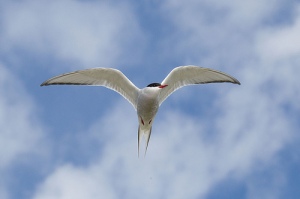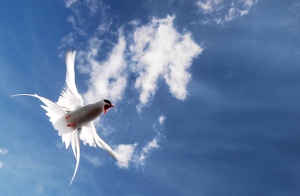Iceland… a useful word in northern Britain at this time of year. Iceland is, of course, a country further north (and significantly colder) than even the northernmost parts of Scotland, my new stomping ground. It’s also a UK supermarket that, according to this YouGov poll, is “the 10th most popular supermarket chain and the 7th most famous.” However, that’s not why I want to talk about Iceland.
Iceland is also the name of an attractively pale seabird – the Iceland Gull Larus glaucoides. Wintering in coastal areas of the UK in small numbers (circa 240 birds a year), it’s identified by its size, structure and – when fully-grown – strikingly clean white plumage. Last week, I was fortunate enough to encounter a young one at Hogganfield Loch on the edge of Glasgow. This week’s birding task was equally gull-ish: catching up with a very well-behaved Ring-billed Gull Larus delawarensis, an even more seldom visitor from America. (I wonder – will its decline in the British Isles continue?) The gorgeous, and reasonably socially-distanced, Strathclyde Loch provided a marvellous backdrop for a creature far from home. Living somewhere cold and wet does have its advantages if you like winter seabirds.
Living somewhere cold, wet and blatantly not English has also made me more aware of the UK’s northerly neighbours – including Norway and Iceland. The aforementioned countries were therefore on the brain when I began a new project in the kitchen – cooking and eating the (or ‘a’) national dish from every country in the world.
Now, I don’t think this blog will ever become a food-only blog, but food and wildlife conservation do have a strong link. Humans have eaten a good few species to extinction, are still having a good crack at that (and consequently picking up diseases like Covid-19), and have spent a good 60 years making drastic changes to our food-production landscapes. Gone are many of the traditionally-managed systems that allowed farming and wildlife to coexist in relative harmony, often replaced by chemical-heavy monocultures and intensive meat-rearing set-ups (but potentially on smaller areas of land). This may or may not be a good thing – but certainly has effects on natural systems. It is without reservations, therefore, that I may let at least a few of these culinary adventures join the fray of wildlife stories.
‘Adventure’ would be the right word to describe Iceland’s alleged national dish. Hákarl is the meat of a sleeper shark species, usually the Greenland shark Somniosus microcephalus, fermented to the tune of 5-7 months. To add to the excitement, the flesh of the shark (which may live for a whopping 500 years or more), is toxic unless carefully prepared. Hákarl is seemingly as much or more of a tourist thing than a high-feast treat, and certainly not a staple – but firmly part of Iceland’s cultural landscape.
Either way, starting my project with preserved shark raises a number of questions. Where do I get sleeper shark? Should I even buy some, or is the species in danger of over-exploitation? I have a shark conservationist friend who campaigns against the eating of any shark… and I certainly couldn’t serve it to vegan or non-pescatarian vegetarian guests. (One day, entertaining at home will become legal again in Scotland. What a strange world we inhabit.)
In the end, I decided to start closer to home… and the story of that is for next time.






